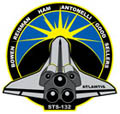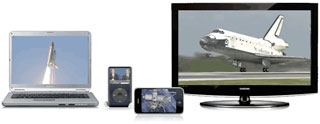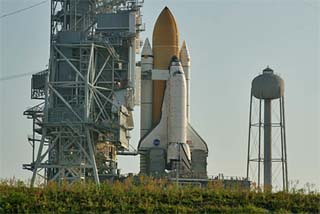 Orbiter: Atlantis Mission: STS-132 Payload: MRM 1 Launch: May 14, 2010 Time: 2:20 p.m. EDT Site: Pad 39A, Kennedy Space Center Landing: May 26 @ approx. 8:30 a.m. Site: KSC's Shuttle Landing Facility 
|
Mission Status Center
Welcome to Spaceflight Now's live coverage of space shuttle Atlantis' STS-132 mission to the International Space Station. Text updates will appear automatically; there is no need to reload the page. TUESDAY, MAY 18, 2010
Flight Day 5 has been completed and the stage is set for Wednesday's spacewalk to begin the two-EVA process to replace a half-dozen batteries on the space station's oldest power truss. The rework of the timeline now shows the spacewalk beginning a little after 7 a.m. EDT. The crew will be awakened at 2:20 a.m. EDT.
1630 GMT (12:30 p.m. EDT)
Mission Control has decided to move up preparations for tomorrow's spacewalk by 30 minutes in hopes of getting the crew out the door early. Ever since the cable on the shuttle's inspection boom got snagged on Saturday, managers have looked at adding a task to one of the EVAs for an astronaut to untangle the pinched cord. So that looks like it will happen tomorrow.
Upcoming this afternoon, a series of cable news interviews with MSNBC, FOX and CNN is scheduled for 2:20 p.m. EDT. After that, the crew will finish reviewing plans for the spacewalk and then Steve Bowen and Mike Good can start their overnight campout in the airlock. 1315 GMT (9:15 a.m. EDT)
Using robotic precision in place of brute force, a nine-ton Russian module loaded with U.S. supplies and equipment was successfully attached to the International Space Station early today after an orbital "hole in one" by robot arm operator Garrett Reisman.
Read our full story. 1235 GMT (8:35 a.m. EDT)
The arrival of Rassvet means the International Space Station assembly is 93 percent complete by mass and 98 percent complete by volume. The station's mass has grown to 816,349 pounds.
1232 GMT (8:32 a.m. EDT)
Rassvet, Russia's Mini Research Module 1, is now part of the International Space Station. The module is where future Soyuz crew transports will be parked, Progress cargo freighters can be unloaded and an added area to house science investigations run by the cosmonauts.
1231 GMT (8:31 a.m. EDT)
At 8:30 a.m. EDT, the hooks and latches were confirmed closed!
1230 GMT (8:30 a.m. EDT)
Hooks and latches between Rassvet and Zarya are being closed to firm a secure mating of the two Russian modules.
1229 GMT (8:29 a.m. EDT)
Rassvet's docking probe has retracted fully.
1229 GMT (8:29 a.m. EDT)
Good alignment confirmed between the interfaces of Rassvet and Zarya.
1226 GMT (8:26 a.m. EDT)
The docking probe on the nose of Rassvet is retracting itself to draw the module into a tight seal with its new home on the Earth-facing port of Zarya.
1225 GMT (8:25 a.m. EDT)
The "go" has been voiced by CAPCOM Steve Swanson to the astronauts for docking probe retraction.
1220 GMT (8:20 a.m. EDT)
CAPTURE CONFIRMED! Rassvet has been robotically docked to the International Space Station at 8:19 a.m. EDT. Initial latches inside the receptacle have triggered and grabbed ahold of the incoming module's docking probe.
1219 GMT (8:19 a.m. EDT)
This is it. Rassvet is heading to the cone-shaped docking port of Zarya.
1218 GMT (8:18 a.m. EDT)
Space station robotic arm operator Garrett Reisman will move Rassvet at 0.06 feet per second, much faster than a typical arm-controlled module installation but far slower than a Russian vehicle arriving for docking.
1215 GMT (8:15 a.m. EDT)
Final tweaking of the alignment.
1211 GMT (8:11 a.m. EDT)
Now approaching an orbital sunrise over the coast of Chile.
1205 GMT (8:05 a.m. EDT)
The crew is going to wait for orbital sunrise before pushing on.
1200 GMT (8:00 a.m. EDT)
"You have a 'go' for docking of MRM 1," CAPCOM Steve Swanson just radioed the astronauts.
1154 GMT (7:54 a.m. EDT)
The television system on Rassvet has been brought online. The astronauts are awaiting a final "go" from Russian flight controllers to proceed with the module docking.
1149 GMT (7:49 a.m. EDT)
Houston confirms the probe is fully extended.
1146 GMT (7:46 a.m. EDT)
The docking probe is deploying out of the module's nose as designed.
1145 GMT (7:45 a.m. EDT)
Mission Control has given the astronauts a "go" to begin activating Rassvet's docking system.
1137 GMT (7:37 a.m. EDT)
Robot arm operator Garrett Reisman describes the last steps of the Rassvet installation process:
"(Piers) will extend the docking probe out so that it is ready to engage to the space station. So he extends that thing out and we line it up really carefully and then basically what I do then is I just go ramming speed on the robot arm. I just floor it, which is kind of fun," Reisman joked. Channeling Scotty from Star Trek: "I'm giving it all it's got, Captain." Atlantis commander Ken Ham says the crew must strike a delicate balance when maneuvering Rassvet into position for mating with Zarya. "We can't go too fast because we might break the arm. We can't go too slow because the arm may not have enough strength to push through those latches so we're going at basically a slow rate and hopefully we're going to drive it right in and it'll work well," Ham said. 1127 GMT (7:27 a.m. EDT)
Rassvet is poised just a matter of feet away from the docking port.
1121 GMT (7:21 a.m. EDT)
Piers Sellers, a United Kingdom-born astronaut and fluent in the Russian language, will be operating the docking system when Rassvet is attached to the space station.
"I am the MRM 1 whisperer," he joked before launch. "On Flight Day 5, we'll reach in with the arm, pull it out and plug it into the bottom of the Russian segment. What that will give us is a long tube docking extension so spacecraft can dock to the ISS without coming close to other structure. And that's the main function, otherwise it will be a place to put things and do some science." 1111 GMT (7:11 a.m. EDT)
Attaching Rassvet to the space station isn't like any other module before. It doesn't have a berthing mechanism like those used on the U.S., European and Japanese modules that the robot arm has installed. Instead, it is equipped with Russian docking hardware. Astronaut Garrett Reisman explains:
"It's kind of weird how this all came about. But it's originally designed to go up by itself. It has a docking system that allows it to fly alone and it's got a probe on the side and there's a cone on the side of the station and it flies by itself and it kind of rams itself home. And what we're doing instead is we're going to pick it up with the space station robotic arm and grab it and stick the probe into the cone by using the robot arm to put it into place. Nobody really knows if this is going to work which makes it really interesting, so you should stay tuned to see what happens. "But because it wasn't designed to do this, neither the arm nor the module, but a lot of smart people have been working really, really hard on it and they're convinced that it's going to work. But like I say we won't really know until we try it. So it's going to be fun. It's going to be a very unique thing, something we haven't done before. So that's our primary mission objective is that." 1109 GMT (7:09 a.m. EDT)
The module has arrived in the pre-dock waypoint.
1106 GMT (7:06 a.m. EDT)
Rassvet is getting close. It has passed the border between the U.S. and Russian segments of the space station.
1101 GMT (7:01 a.m. EDT)
Atlantis commander Ken Ham describes Rassvet in this pre-flight interview:
"I'm not sure how to better say this. It looks Russian. It looks different. I think when you look at space station you know exactly where the demarcation line is. It's right aft of Node 1. The Russian half looks different than the U.S. half, not that there's anything wrong with either one of them. It's just that they look different. It's something to do with the color of the blankets or maybe just the way they're designed. "On the exterior of MRM 1 there are various spare ORUs, Orbital Replacement Units, that are going to be used on the Russian half later on downstream. There's a radiator, a spare upper and lower arm for the European robotic arm, an airlock that is going to move to MLM, I believe I got that acronym right, later on downstream as the Russians continue to put a couple more pieces of space station up there in years to come." 1057 GMT (6:57 a.m. EDT)
Everything is looking good as Rassvet rides the arm beneath the space station. The module has a mass of 17,760 pounds, a habitable volume of 207 cubic feet, is 7.7 feet in diameter and 19.7 feet long.
1051 GMT (6:51 a.m. EDT)
The process of unberthing Rassvet with one robotic arm, handing off to another arm and then attaching to the space station is explained in detail by Piers Sellers in this pre-flight interview:
"This is like a little ballet. The MRM 1 is sitting clamped inside the payload bay of shuttle for launch, really securely, so the first thing you do is get the shuttle arm, the small arm as we call it insultingly to the shuttle guys, and they will grab the MRM 1. Then we release the clamps and lift it slowly out the payload bay so it's hovering above them. Then the big station arm comes from the other side and grabs it. The shuttle arm lets go. "Station arm swings it all the way over the whole of the belly of station, all the way over, and holds it above a docking port on the Russian side. "At that point, we'll use the laptop to talk to the Russian module, wake it up. It's got two little brains in there and we'll ask it to extend a docking probe. It basically has the same docking system that a Soyuz has, pretty much. We'll extend this little probe and then we'll push it into the station. "As far as station's concerned, it's just like another Soyuz coming and docking so we'll push it in with the arm as opposed to using rockets to drive it in. The probe will go into a cone, latch and then we'll retract the probe so that it pulls the two pieces together, the station and the MRM 1 tight. "Hopefully if it will work out nicely and we'll get a seal and I think sometime, the next day, they'll open up the hatches and see if anybody's stowed away inside." 1048 GMT (6:48 a.m. EDT)
The station's arm is in moving once again. It's begun carrying the 18,000-pound Rassvet toward a permanent home on the Earth-facing side the International Space Station's Zarya module.
1040 GMT (6:40 a.m. EDT)
Atlantis' arm has swung over the port wing, getting out of the way of Rassvet's maneuvering by the station arm. And with that, shuttle arm operator Tony Antonelli has given station arm operator Garrett Reisman a "go" to start moving the module.
1036 GMT (6:36 a.m. EDT)
The robotic arm handoff of Rassvet has been completed. Atlantis' arm just released its grasp, leaving the module with the station arm for today's attachment to Zarya.
1021 GMT (6:21 a.m. EDT)
Rassvet is being powered via the station robotic arm, and Mission Control reports seeing good data from the module.
1014 GMT (6:14 a.m. EDT)
The station arm's has gripped the second grapple fixture on Rassvet. A short time from now, the shuttle's arm will let go and back away.
1009 GMT (6:09 a.m. EDT)
After the shuttle's arm raised Rassvet out of the bay, the module is now within reach of the space station's arm to take over. Garrett Reisman is flying the station arm to grab the module.
0957 GMT (5:57 a.m. EDT)
The Mini Research Module 1, known as Rassvet, is the first and only major piece of Russian hardware that the U.S. will haul to the International Space Station. It will be attached to the Earth-facing port of the Zarya control module, the original piece of the station launched in November 1998.
"It's about the size of a small Winnebago. It's a bit cylindrical and when it's plunked onto the bottom of station it'll basically have a docking port that's much lower than the rest of the bulk of station so the vehicles can come in and dock without getting into this little zone of other hardware on station. It's like a standoff," Atlantis astronaut Piers Sellers said in a pre-flight interview. "The Russian company, Energia, has been making that. It's converted from a previous piece of hardware that they had lying around so they've been busy making that for the last couple years. We'll fly that up for them." 0950 GMT (5:50 a.m. EDT)
Space shuttle Atlantis' robotic arm is slowly beginning to pull the Rassvet module out of the payload bay.
0946 GMT (5:46 a.m. EDT)
The remotely controlled power umbilical between the shuttle and Rassvet has been disengaged, and the astronauts are commanding the restraining latches to open for the module's unberthing.
0910 GMT (5:10 a.m. EDT)
Astronauts Garrett Reisman, operating the space station's robot arm, and Piers Sellers, sending commands from a laptop computer, plan to attach a nine-ton Russian module to the International Space Station today in a complex operation blending U.S. and Russian docking systems.
Read our full story. 0850 GMT (4:50 a.m. EDT)
The latest version of the NASA Television schedule (Rev. C) can be downloaded here.
0652 GMT (2:52 a.m. EDT)
A day to build another room on the International Space Station has begun for the astronauts. Flight Day 5 will see the Russian Rassvet module unberthed from Atlantis' payload bay by the shuttle robotic arm. It'll be handed off to the space station's arm and then attached to the Earth-facing port of the Zarya module to become a new docking compartment for visiting Russian spacecraft and a mini science lab.
The work is scheduled to begin around 5 a.m. EDT, with Rassvet connecting to the station about three hours later. Read our earlier status center coverage. |

Space video for your computer, iPod or big screen TV
Experience the space program like never before become a subscriber today |



